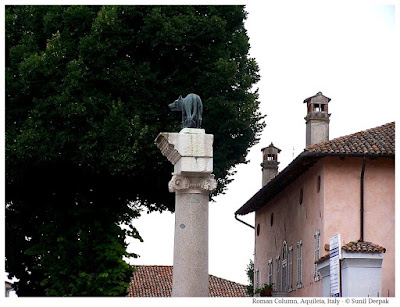Roman Town of Aquileia
Aquileia is situated in the north-eastern part of Italy, not far from the modern day Austria, Slovenia and Croatia. Before the arrival of the Romans, Celtic people lived here and called it Akylis. At that time it was an important centre for the trade of amber.
Aquileia became a Roman colony in 181 BCE. It was the Roman frontier-town in the north for launching military campaigns in the northern and eastern Europe. Around 58 BC, Julius Ceasar established here his command centre (the Circum Aquileie) and it became the capital of the whole region. Around 300 CE, the emperor Maximillian built a big palace in Aquileia.
Situated on the banks of river Natiso and just 13 km from the sea, Aquileia was an important port city controlling the local trade. Caesar visited it many times and a good road network connected it to other cities like Bologna and Genoa.
At its peak the city's population was one hundred thousand and it was one of the biggest cities in the world. However, by the fifth century CE, the western part of Roman empire were already in decline and thus, slowly Aquileia lost its strategic importance. Around 1,100 CE though the city had become less important, it was still a big Roman town and a new big cathedral was built here. In the medieval period, it passed under the Republic of Venice and then in 19th century, under the Austrian-Hungerian empire.
More recently, during the First World war, fighting took place in Aquileia. After the war, Aquileia became part of Italy.
Today Aquileia is a tiny hamlet with a population of only 3,500 persons. However because of its history, it is one of the major archaeological sites in northern Italy.
Roman ruins of Aquileia
Passing armies, wars, floods, earthquakes and the passage of time, have destroyed all the Roman period buildings of Aquileia. Some archaeological excavations have brought out the old roads and foundations of important buildings such as amphitheatre, forum and the port.
Aquileia has a beautiful basilica church from 11th century, built over an older church. The bell tower of the basilica is visible from far away. The facade of the church is in Romanesque-early Gothic style.
Behind the basilica a path connects this area to the ruins of the old Roman port. This area also has a military cemetery from the first world war.
Candia Memorial
A round shaped monument called "Candia Memorial" was built in Aquileia in 1956. The stones and materials from a two thousand years old tomb, discovered in 1952 in the nearby Roncolon of Fiumicello, were used to build this memorial.
Conclusions
Today when you visit Aquileia, its magnificent ruins give some idea of the importance of this ancient town during the expansion of Roman empire. Yet, it is difficult to imagine that this far away, isolated place was one of the biggest cities in the ancient world.
However if you are visting this part of Italy for some seaside holidays, do visit Aquileia and the nearby island of Grado.
***















Very detailed account of this ancient town! :)
ReplyDeleteThank you 2travelling sisters for your appreciation! I hope this does not mean that the information was too much! :)
Delete